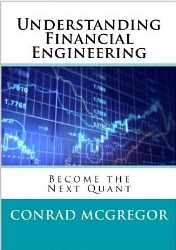The media and financial blogs have been all over high frequency and “flash” trading. The key fact is that since 2003, high frequency trading has gone from a bit over 20% of the average daily trade volume to over 70% in 2009. The scary truth that 70% of shares are traded by computers in fractions of a second without any care for underlying fundamentals is frightening and does deserve much consideration.
The oft cited example of “program trading” gone awry is portfolio insurance and the 1987 market crash. The main idea is that you can protect your long stock portfolio by buying put options that are out of the money. Put options purchased on the option exchanges are expensive so some traders bypassed the option market entirely (thanks to black-scholes option pricing model) and delta hedged daily to replicate a put option. So a put option can be offset by someone willing to sell a put option naked (not a lot of natural sellers as I suggested in Picking up Nickels in Front of a Steamroller) or the market maker can hedge his risks by replicating the option by selling stock. The key problem here is that as the market goes down the option market maker or option replicator must sell more stock. This is a positive feedback loop in which the trader propagates a sliding market by selling more stock and was possibly a major force in the crashing market of ’87. If you would like to read more about it I would suggest the entertaining book by Richard Bookstaber entitled “Demon of our Own Design“.
Now let’s move to the more modern demon, the high frequency trader or “black box”. These are computer algorithms designed my PhD’s in physics, computer science, and statistics. These algorithms are meant to hunt out statistically significant patterns within the financial markets and exploit them. The methods can vary significantly from finding discrepancies between the prices two like securities (arbitrage), to jumping quickly in and out of momentum plays, to finding spread differences between two similar but not entirely related securities (pairs trading/statistical arbitrage). What is frightening is that we cannot know how all of these different black boxes interact in the real world. We do not know if these black boxes caused much of the volatility in 2008 or whether that would have occurred without these soulless machines. When a system gets incredibly complex and interwoven, then we turn to the butterfly effect to question whether these seemingly innocuous fractional of a second trades can cause a catastrophic collapse of financial markets.
So let’s segue away from the “doomday” prediction of catastrophic proportions, and turn to known problems with high frequency trading. If the black boxes are making money (which some says is in the $100’s of billions of dollars per year) then the money must be coming from somewhere. That somewhere is every regular retail and institutional investor in the form of higher transaction costs. There is a thought that all of this trading provides liquidity, but these boxes are not of a true liquidity providing nature, they are merely in it for the quick buck. If the markets turn directional, then chances are they are going to be trying to sell along with you as their algorithm tells them.
I will touch on this topic more in the future as I explore more subtle nuances of the market participants, but if you do not trust my opinion then read Paul Wilmott’s (considered the father of quantitative finance) opinion in today’s New York Times Op-Ed piece entitled “Hurrying into the Next Panic“.



